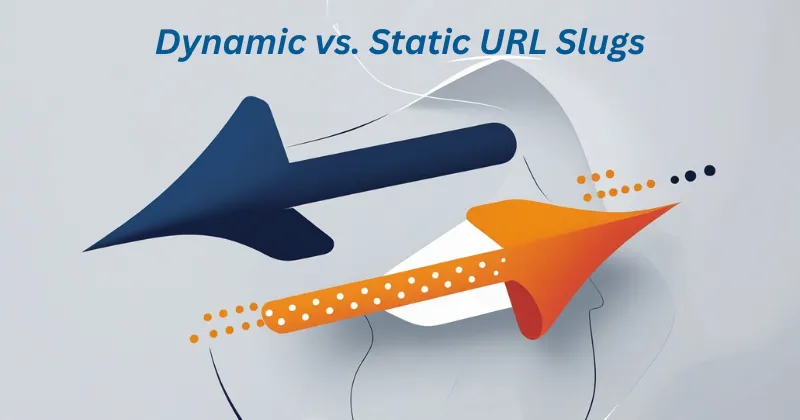Dynamic vs. Static URL Slugs is a choice you’ll face when building or managing a website, and it’s all about how you structure your URLs. A key part of this is the URL slug—the section of the web address that identifies a specific page. There are two main types of URL slugs: dynamic and static. Each has its own benefits and drawbacks, and choosing the right one depends on your website’s goals. In this article, we’ll explain what dynamic and static URL slugs are, how they work, and when to use each one. By the end, you’ll know which is better for your website.
What Are URL Slugs?
A URL slug is the part of a web address that comes after the domain name and describes the page’s content. For example, in the URL https://www.example.com/blog/how-to-cook-pasta, the slug is how-to-cook-pasta. Slugs help both users and search engines (like Google) understand what a page is about. They can be static (fixed and unchanging) or dynamic (generated automatically based on data). Let’s explore the differences.
What Are Static URL Slugs?
Static URL slugs are manually created and stay the same unless you change them yourself. They are often short, descriptive, and written by a person to reflect the page’s content. For example: https://www.example.com/about-us or https://www.example.com/products/red-shoes. With static slugs, you decide the exact wording when you create a page. If you’re using a website builder like WordPress, you might type the slug into a field when writing a blog post or setting up a page. The slug doesn’t change unless you edit it manually.
Advantages of Static URL Slugs
Static slugs are clear and readable—something like best-laptop-reviews tells users exactly what to expect. They’re great for SEO because search engines love descriptive, keyword-rich slugs, which can boost your ranking. Since they don’t change automatically, static slugs avoid broken links or confusion if content updates. Plus, you have full control over how the slug looks, so you can make it short, memorable, and on-brand.
Disadvantages of Static URL Slugs
You have to create each slug yourself, which can take time if you have lots of pages. They’re not flexible—if your content changes (like a product name), you might need to update the slug manually, which could affect links pointing to that page. For websites with thousands of pages, writing unique static slugs for everything can be overwhelming.
What Are Dynamic URL Slugs?
Dynamic URL slugs are generated automatically by your website based on data, often from a database. They usually include variables like product IDs, dates, or categories. For example: https://www.example.com/product?id=12345 or https://www.example.com/blog/2023/10/post-567. Dynamic slugs are created by a system, not a person. For instance, an e-commerce site might use a product’s ID number or name pulled from a database to build the slug. Tools like WordPress or content management systems (CMS) can generate dynamic slugs automatically when you add new content.
Advantages of Dynamic URL Slugs
Dynamic slugs save time—you don’t need to write them manually, which is perfect for large sites. They’re scalable, working well for websites with tons of pages, like online stores or news sites, where new content is added often. If content changes (like a product name or category), the slug can update automatically based on the database. The system follows a set pattern, so all slugs look uniform without extra effort.
Disadvantages of Dynamic URL Slugs
Slugs like product?id=12345 aren’t user-friendly and don’t tell people what the page is about. Search engines prefer descriptive slugs, so dynamic slugs with numbers or random strings might hurt your ranking. If the system generates a slug wrong or the database changes, it could lead to broken links or duplicate URLs.
When to Use Static URL Slugs
Static URL slugs are best for websites where control, readability, and SEO are top priorities. If you run a small site—like a personal blog, portfolio, or business page—static slugs are easy to manage. For example, a blog post titled “Top 10 Travel Tips” could have a slug like top-10-travel-tips. For pages you want to rank high on Google, static slugs let you add keywords—a page about “best running shoes” with a slug like best-running-shoes is more likely to show up in search results than product?id=789. Static slugs are also perfect for permanent pages that don’t change often, like about-us, contact, or services. If branding matters, static slugs give you the freedom to craft something memorable, like green-living-tips for a company called “Green Living”.
When to Use Dynamic URL Slugs
Dynamic URL slugs shine on websites with lots of content or frequent updates. Online stores with thousands of products can’t manually create slugs for every item—a dynamic slug like shop/shoes/red-sneakers-123 (generated from a product name and ID) saves time and keeps things organized. News sites publish articles daily, so dynamic slugs based on dates or post IDs (e.g., news/2023/10/article-456) ensure every new post gets a unique URL without extra work. If your site pulls content from a database—like a job board or directory—dynamic slugs make it easy to handle large amounts of data.
Can You Mix Both?
Yes! Many websites use a mix of static and dynamic slugs to get the best of both worlds. For example, a blog might use static slugs for main pages (like about or contact) and dynamic slugs for posts (like blog/2023/post-123). An online store could use static slugs for category pages (e.g., shoes) and dynamic slugs for individual products (e.g., shoes/item-456). This hybrid approach gives you control where it matters and automation where it saves time.
QR Codes vs. Short URLs: When to Use Which?
Dynamic vs. Static URL Slugs at a Glance
Here’s a quick comparison to help you decide:
| Feature | Static Slugs | Dynamic Slugs |
|---|---|---|
| Creation | Manual | Automatic |
| Readability | High | Low |
| SEO | Strong | Weaker |
| Scalability | Hard for large sites | Great for large sites |
| Flexibility | Fixed | Updates with data |
Final Tips for Choosing
Ask yourself these questions to pick the right option: How big is your website? Small sites with few pages do well with static slugs, while large sites benefit from dynamic ones. How important is SEO? If ranking high on Google matters, lean toward static slugs with keywords. How often does your content change? Static slugs work for stable pages, while dynamic slugs handle frequent updates. You can also use tools like Yoast SEO to optimize slugs on platforms like WordPress, whether they’re static or dynamic.
Conclusion
There’s no one-size-fits-all answer to whether static or dynamic URL slugs are better—it depends on your website’s needs. Static slugs offer control, readability, and SEO benefits, making them ideal for small sites or permanent pages. Dynamic slugs save time and scale easily, perfect for large or fast-growing sites. In some cases, using both together can give you flexibility and efficiency. Think about your goals—size, SEO, and maintenance—and choose the approach that fits. With the right slugs, your URLs can work harder for your website’s success!

